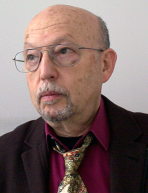


Ph.D., California Institute of Technology
Postdoctoral, Yale University
Global Genome Sequence Homology. The number of species for whom the “complete” genetic map has been elucidated, as far as DNA sequence, is nearly ten thousand. These range from the viruses to the animal and plant kingdoms. In the most simple organisms, viruses and prokaryotic, all or almost all of the DNA is organized into genes that code for proteins. For more complex organisms a smaller fraction of all DNA base-pair constitutes protein-coding genes. We have calculated the homology for the approximately 600 million pair-wise gene sequences of Homo sapiens with Caenorhabditis elegans. For the vast majority of human genes, there is one gene, or a few genes, from the roundworm that is, or are, homologous to a greater or lesser degree. Beyond that the homology values fall to a background level range determined by comparing with random sequences. There are, however, a few human genes that have homology with several hundred of the roundworm genes. For several human genes, we also observe homology values with numerous genes from the roundworm that, although the homology is very low, it is significantly above the level of homology found with background, random sequences. We are extending our investigation to many other species to determine the degree of generality of these observations. We are also extending our investigation to comparing homologies in non-protein coding regions of DNA, to attempt to determine the origin of low level homology values in relationship with DNA sequence evolution.
Ontology for Medical Education and the Semantic Web. We are building a comprehensive ontology to enable the storage and analyses of data in a graph-based W3C RDF/linked-data technologies, for all aspects of medical education. The current paradigm consists of a large number of relational databases at the approximately130 schools in the US. This variety poses great difficulties and cost when attempting to compare the various curricula, assessments, and outcomes, as currently done by the American Association of Medical Colleges and agencies they subcontract. Adoption of a semantic web approach will result in increased efficiencies as well as enable the discovery of new relationships.
Huang, P. and Eisenberg, M. (1993). The solution structure of exocyclic 1,N2-propanodeoxyguanosine adduct opposite deoxyadenosine in a DNA 9-mer duplex at pH 8.9. Model of pH-dependent conformational transition. Biochemistry 32: 3852-3866.
Grollman, A.P., Johnson, F., Tchou, J., and Eisenberg, M. (1994). Recognition and repair of 8-oxoguanine and formamidopyrimidine lesions in DNA. Ann. N. Y. Acad. Sci. 726: 208-214.
Schwarzman, A.L., Gegori, L., Vitek, M.P., Lyubski, S., Strinmatter, W.J., Enghilde, J.J., Bahsin, R. Silverman, J., Weisgraber, K.H., Coyle, P.K., Zagorski, M.G., Talafus, J., Eisenberg, M., Saunders, A.M., Roses, A.D., and Goldgaber, D. (1994). Transthyretin sequesters amyloid beta protein and prevents amyloid formation. Proc. Natl. Acad. Sci. USA 91: 8368-8372.
Peitzsch, R.M., Eisenberg, M., Sharp, KA., and McLaughlin, S. (1995). Calculations of the electrostatic potential adjacent to model phospholipid membranes. Biophys. J. 68: 729-738.
Deng, Yuefan; Glimm, James; Wang, Yuan; Korobka, Alexandre; Eisenberg, Moises; and Grollman, Arthur P. (1999) Prediction of Protein Binding to DNA in the Presence of Water-Mediated Hydrogen Bonds. J. Mol. Model. 5(7-8), 125-133.
Cullinan, D.; Eisenberg, M.; De Los Santos, C. (1999). Solution Structures of DNA Duplexes containing the exocyclic lesion 3,n4-etheno-2'-deoxycytidine. in "Exocyclic DNA Adducts in Mutagenesis and Carcinogenesis", IARC/WHO No. 150. B. Singer and H. Bartsch, Eds.